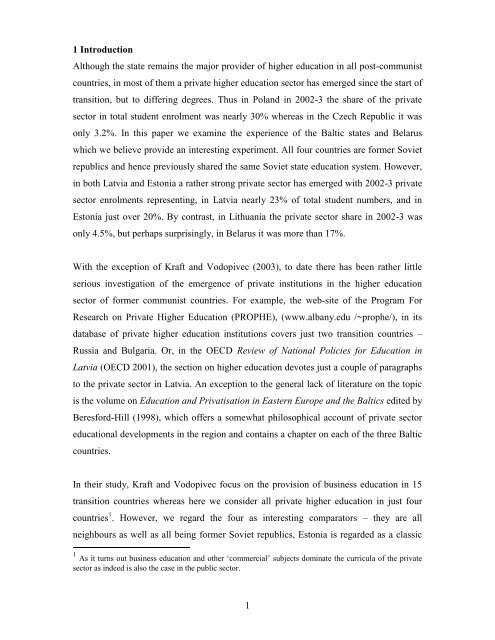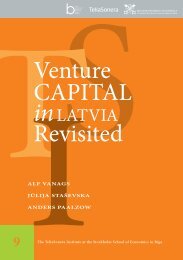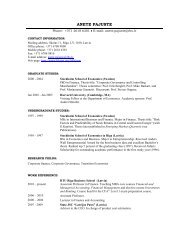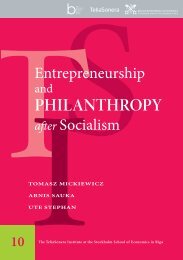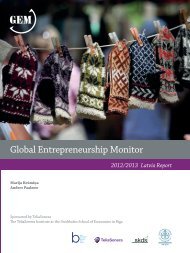A. Vanags, M. Hansen, 2005 - BICEPS
A. Vanags, M. Hansen, 2005 - BICEPS
A. Vanags, M. Hansen, 2005 - BICEPS
Create successful ePaper yourself
Turn your PDF publications into a flip-book with our unique Google optimized e-Paper software.
1 Introduction<br />
Although the state remains the major provider of higher education in all post-communist<br />
countries, in most of them a private higher education sector has emerged since the start of<br />
transition, but to differing degrees. Thus in Poland in 2002-3 the share of the private<br />
sector in total student enrolment was nearly 30% whereas in the Czech Republic it was<br />
only 3.2%. In this paper we examine the experience of the Baltic states and Belarus<br />
which we believe provide an interesting experiment. All four countries are former Soviet<br />
republics and hence previously shared the same Soviet state education system. However,<br />
in both Latvia and Estonia a rather strong private sector has emerged with 2002-3 private<br />
sector enrolments representing, in Latvia nearly 23% of total student numbers, and in<br />
Estonia just over 20%. By contrast, in Lithuania the private sector share in 2002-3 was<br />
only 4.5%, but perhaps surprisingly, in Belarus it was more than 17%.<br />
With the exception of Kraft and Vodopivec (2003), to date there has been rather little<br />
serious investigation of the emergence of private institutions in the higher education<br />
sector of former communist countries. For example, the web-site of the Program For<br />
Research on Private Higher Education (PROPHE), (www.albany.edu /~prophe/), in its<br />
database of private higher education institutions covers just two transition countries –<br />
Russia and Bulgaria. Or, in the OECD Review of National Policies for Education in<br />
Latvia (OECD 2001), the section on higher education devotes just a couple of paragraphs<br />
to the private sector in Latvia. An exception to the general lack of literature on the topic<br />
is the volume on Education and Privatisation in Eastern Europe and the Baltics edited by<br />
Beresford-Hill (1998), which offers a somewhat philosophical account of private sector<br />
educational developments in the region and contains a chapter on each of the three Baltic<br />
countries.<br />
In their study, Kraft and Vodopivec focus on the provision of business education in 15<br />
transition countries whereas here we consider all private higher education in just four<br />
countries 1 . However, we regard the four as interesting comparators – they are all<br />
neighbours as well as all being former Soviet republics, Estonia is regarded as a classic<br />
1 As it turns out business education and other ‘commercial’ subjects dominate the curricula of the private<br />
sector as indeed is also the case in the public sector.<br />
1


